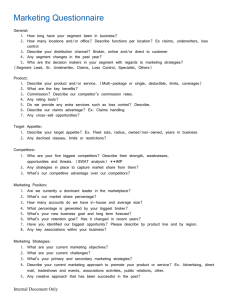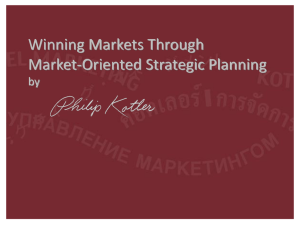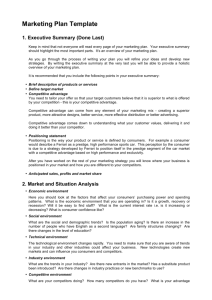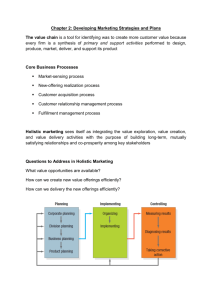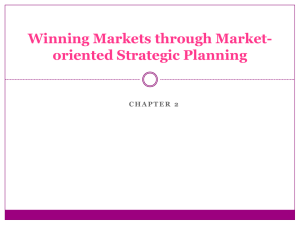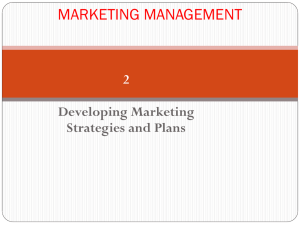The Marketing Plan
advertisement
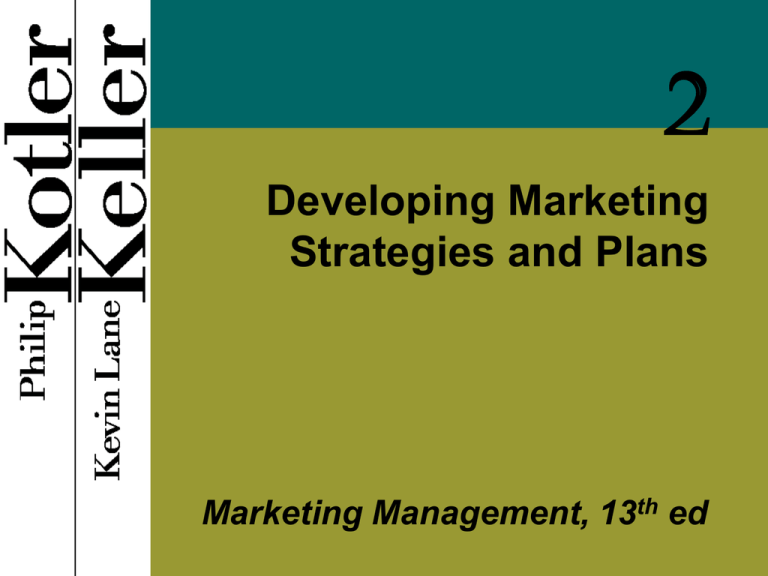
2 Developing Marketing Strategies and Plans Marketing Management, 13th ed Chapter Questions • How does marketing affect customer value? • How is strategic planning carried out at different levels of the organization? • What does a marketing plan include? 2-2 3 V’s Approach to Marketing Define the value segment (needs and wants) Define the value proposition (benefits) Define the value network to deliver promise services. 2-3 What is the Value Chain? The value chain is a tool for identifying and creating more customer value because every firm is a synthesis of primary activities: • Inbound logistics--bringing materials into business, • Operations--converting materials into final products, • Outbound logistics--shipping out final products, • Marketing products, • Servicing products and support activities • Procurement, • Technology development, • Human resource management, • Firm infrastructure—costs of general management, planning, finance, accounting, legal, and government affairs performed to design, produce, market, deliver, and support its product. 2-4 Core Business Processes • Market-sensing process (marketing intelligence). • New-offering realization process (research and development). • Customer acquisition process (defining target markets and consumers). • Customer relationship management process (deeper understanding of consumers). • Fulfillment management process (receiving, shipping, and collecting payments). 2-5 Competitive Advantage Competitive advantage: the firm has a marketing mix that the target market sees as better than a competitor's mix • A better marketing mix offers target customers better customer value • Note: customers who are not in the target market may not see the marketing mix as offering better value Requires that the firm: • understand current competitors' offerings • anticipate competitors' likely plans • monitor effects of changes in competition • really understand the target customers' needs Characteristics of Core Competencies • A source of competitive advantage (technical, production expertise, distribution, financial strength, etc.) • Applications in a wide variety of markets • Difficult to imitate 2-7 Examples of Company Resources That May Result in Competitive Advantage Financial strength (Intel) Producing flexibility (DaimlerChrysler) Patents (IBM) Channel relationships (Kraft) Loyal customer base (Starbucks) Technical capability (3M) Becoming a Vigilant Organization • Can we learn from the past? • How should the present be evaluated? • What do we envision for the future? 2-9 What is Holistic Marketing? Holistic marketing sees itself as integrating the value exploration, value creation, and value delivery activities with the purpose of building long-term, mutually satisfying relationships among key stakeholders. 2-10 What is a Marketing Plan? A marketing plan is the central instrument for directing and coordinating the marketing effort. It operates at a strategic and tactical level. 2-11 Levels of a Marketing Plan • Strategic • Tactical • Target marketing decisions • Value proposition • Analysis of marketing opportunities 2-12 • • • • • • Product features Promotion Merchandising Pricing Sales channels Service Relation of Strategy Policies to Operational Decisions for Baby Shoe Company UNSEGMENTED MARKET STRATEGY WITH A SINGLE MARKETING MIX COMMUNITY WRITING COMPANY MARKETING MIX VIEW OF MARKET •LEAD PENCIL •79 CENTS •TELEVISION •EXTENSIVE DISTRIBUTION ALL POTENTIAL USERS OF A WRITING INSTRUMENT 14 SEGMENTED MARKETING STRATEGY WITH MULTIPLE MARKETING MIXES MARKETING MIXES •FELT-TIP PEN •$1.00 •CAMPUS NEWSPARER •VENDING MACHINES VIEW OF MARKET SEGMENT A (STUDENTS) •FELT-TIP PEN •49 CENTS •PERSONAL SELLING •DIRECT FROM FACTORY SEGMENT B (PROFESSORS) •GOLD INK PEN •$50.00 •MAGAZINES •DEPARTMENT STORES SEGMENT C (EXECUTIVES) 15 A SEGMENTED MARKETING STRATEGY WITH SINGLE MARKETING MIX MARKETING MIX VIEW OF MARKET SEGMENT A (PROFESSORS) •FELT-TIP PEN •$1.00 •CAMPUS NEWSPARER •VENDING MACHINES SEGMENT A (STUDENTS) SEGMENT C (EXECUTIVES) Corporate Headquarters’ Planning Activities • Define the corporate mission • Establish strategic business units (SBUs) • Assign resources to each SBU • Assess growth opportunities 2-17 Good Mission Statements • • • • • Focus on a limited number of goals Stress major policies and values Define major competitive spheres Take a long-term view Short, memorable, meaningful 2-18 Major Competitive Spheres • Industry (consumer(s) and/or industrial(s) • Products (range) • Competence (technological, production, etc.) • Market segment (type of market or customer) • Vertical channels (number of channel levels, from raw materials to final product and distribution) • Geographic (range of regions, countries, or country groups) 2-19 Rubbermaid Commercial Products, Inc. “Our vision is to be the Global Market Share Leader in each of the markets we serve. We will earn this leadership position by providing to our distributor and end-user customers innovative, high-quality, costeffective and environmentally responsible products. We will add value to these products by providing legendary customer service through our Uncompromising Commitment to Customer Satisfaction.” 2-20 Motorola “The purpose of Motorola is to honorably serve the needs of the community by providing products and services of superior quality at a fair price to our customers; to do this so as to earn an adequate profit which is required for the total enterprise to grow; and by doing so, provide the opportunity for our employees and shareholders to achieve their personal objectives.” 2-21 eBay “We help people trade anything on earth. We will continue to enhance the online trading experiences of all—collectors, dealers, small businesses, unique item seekers, bargain hunters, opportunity sellers, and browsers.” 2-22 Product Orientation vs. Market Orientation Company Product Market Missouri-Pacific Railroad We run a railroad We are a peopleand-goods mover Xerox We make copying equipment We improve office productivity Standard Oil We sell gasoline We supply energy Columbia Pictures We make movies We entertain people 2-23 Dimensions that Define a Business • Customer groups (e.g., individuals, businesses) • Customer needs (e.g., functional, aesthetic, etc.) • Technology (e.g., digital, chemical, etc.) 2-24 Characteristics of SBUs • It is a single business or collection of related businesses • It has its own set of competitors • It has a leader responsible for strategic planning and profitability 2-25 Ansoff’s Product-Market Expansion Grid 2-26 Examples of Different Types of Opportunities Market Penetration • Arm & Hammer promotes new uses of its baking soda Market Development • Marriott Hotels target families for weekend get-aways to rent rooms filled by business travelers during the week Product Development • Microsoft develops a new version of its Windows operating system to appeal to the people who bought an earlier version but now want more features Diversification • RJR, the cigarette producer, adds baked goods to its product line to appeal to new customers What is Corporate Culture? Corporate culture is the shared experiences, stories, beliefs, and norms that characterize an organization. 2-28 Tactics for Managing Change • • • • • Avoid the innovation title for the team Use the buddy system Set the metrics in advance Aim for quick hits first Get data to back up your gut 2-29 SWOT Analysis • • • • Strengths Weaknesses Opportunities Threats 2-30 Market Opportunity Analysis (MOA) • Can the benefits involved in the opportunity be articulated convincingly to a defined target market? • Can the target market be located and reached with cost-effective media and trade channels? • Does the company possess or have access to the critical capabilities and resources needed to deliver the customer benefits? 2-31 Market Opportunity Analysis (MOA) (cont.) • Can the company deliver the benefits better than any actual or potential competitors? • Will the financial rate of return meet or exceed the company’s required threshold for investment? 2-32 Goal Formulation and MBO • • • • Unit’s objectives must be hierarchical Objectives should be quantitative Goals should be realistic Objectives must be consistent 2-33 Porter’s Generic Strategies Overall Cost Leadership—lowest production and distribution costs to be able to price lower than competitors and to obtain larger market share. Differentiation—uniquely achieving superior performance in an important customer benefit area. Focus—on one or more narrow market segments 2-34 Categories of Marketing Alliances Product or Service Alliances—jointly market complementary products Promotional Alliances—promotion of another company’s products Logistics Alliances—logistical services for another company’s products. Pricing Collaborations—one or more companies join in special price reduction. 2-35 The Strategic Planning Gap 2-36 The Business Unit Strategic Planning Process 2-37 The Marketing Plan Marketing plan: a written statement of a marketing strategy and the time related details for carrying out the strategy. Spells out, in detail: • • • • What marketing mix is to be offered To what target market For how long What resources (costs) are needed at what rate • What results are expected • What control procedures will be used. Marketing Plan Contents Executive summary Table of contents Situation analysis Marketing strategy Financial projections Implementation controls 2-39 Evaluating a Marketing Plan Is the plan simple? Is the plan specific? Is the plan realistic? Is the plan complete? 2-40 Challenges Facing CMO’s Doing more with less Driving new business development Becoming a full business partner 2-41 Study Question 1 The ________ is a tool for identifying ways to create more customer value. A. value chain B. customer survey C. brand loyalty index D. promotion channel E. supplier database 2-42 Study Question 2 A good way to describe the ________ would be to discuss all the activities involved in building deeper understanding, relationships, and offerings to individual customers. A. customer acquisition process B. customer relationship management process C. customer prospecting process D. customer fulfillment management process E. customer equity process 2-43 Study Question 3 Core competencies tend to refer to areas of special technical and production expertise, whereas ________ tend to describe excellence in broader business processes. A. B. C. D. E. process benchmarks distinctive capabilities core business values value statements mission statements 2-44 Study Question 4 The ________ is the central instrument for directing and coordinating the marketing effort. A. B. C. D. E. strategic plan marketing plan tactical plan customer-value statement corporate mission 2-45 Study Question 5 The ________ lays out the target markets and the value proposition that will be offered, based on an analysis of the best market opportunities. A. B. C. D. E. organizational plan strategic marketing plan corporate tactical plan corporate mission customer-value statement 2-46
